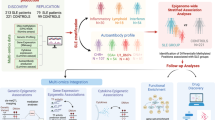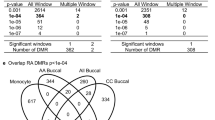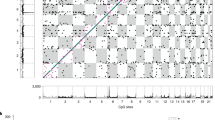Abstract
Epigenetic mechanisms integrate genetic and environmental causes of disease, but comprehensive genome-wide analyses of epigenetic modifications have not yet demonstrated robust association with common diseases. Using Illumina HumanMethylation450 arrays on 354 anti-citrullinated protein antibody–associated rheumatoid arthritis cases and 337 controls, we identified two clusters within the major histocompatibility complex (MHC) region whose differential methylation potentially mediates genetic risk for rheumatoid arthritis. To reduce confounding factors that have hampered previous epigenome-wide studies, we corrected for cellular heterogeneity by estimating and adjusting for cell-type proportions in our blood-derived DNA samples and used mediation analysis to filter out associations likely to be a consequence of disease. Four CpGs also showed an association between genotype and variance of methylation. The associations for both clusters replicated at least one CpG (P < 0.01), with the rest showing suggestive association, in monocyte cell fractions in an independent cohort of 12 cases and 12 controls. Thus, DNA methylation is a potential mediator of genetic risk.
This is a preview of subscription content, access via your institution
Access options
Subscribe to this journal
Receive 12 print issues and online access
$209.00 per year
only $17.42 per issue
Buy this article
- Purchase on SpringerLink
- Instant access to full article PDF
Prices may be subject to local taxes which are calculated during checkout





Similar content being viewed by others
Accession codes
References
Feinberg, A.P. & Tycko, B. The history of cancer epigenetics. Nat. Rev. Cancer 4, 143–153 (2004).
Kaminsky, Z.A. et al. DNA methylation profiles in monozygotic and dizygotic twins. Nat. Genet. 41, 240–245 (2009).
Feinberg, A.P. et al. Personalized epigenomic signatures that are stable over time and covary with body mass index. Sci. Transl. Med. 2, 49ra67 (2010).
Javierre, B.M. et al. Changes in the pattern of DNA methylation associate with twin discordance in systemic lupus erythematosus. Genome Res. 20, 170–179 (2010).
Rakyan, V.K. et al. Identification of type 1 diabetes-associated DNA methylation variable positions that precede disease diagnosis. PLoS Genet. 7, e1002300 (2011).
Bjornsson, H.T., Fallin, M.D. & Feinberg, A.P. An integrated epigenetic and genetic approach to common human disease. Trends Genet. 20, 350–358 (2004).
Bjornsson, H.T. et al. Intra-individual change over time in DNA methylation with familial clustering. J. Am. Med. Assoc. 299, 2877–2883 (2008).
Rakyan, V.K., Down, T.A., Balding, D.J. & Beck, S. Epigenome-wide association studies for common human diseases. Nat. Rev. Genet. 12, 529–541 (2011).
Klareskog, L., Catrina, A.I. & Paget, S. Rheumatoid arthritis. Lancet 373, 659–672 (2009).
Scott, D.L., Wolfe, F. & Huizinga, T.W. Rheumatoid arthritis. Lancet 376, 1094–1108 (2010).
Padyukov, L. et al. A genome-wide association study suggests contrasting associations in ACPA-positive versus ACPA-negative rheumatoid arthritis. Ann. Rheum. Dis. 70, 259–265 (2011).
Raychaudhuri, S. et al. Genetic variants at CD28, PRDM1 and CD2/CD58 are associated with rheumatoid arthritis risk. Nat. Genet. 41, 1313–1318 (2009).
Stahl, E.A. et al. Genome-wide association study meta-analysis identifies seven new rheumatoid arthritis risk loci. Nat. Genet. 42, 508–514 (2010).
Raychaudhuri, S. et al. Five amino acids in three HLA proteins explain most of the association between MHC and seropositive rheumatoid arthritis. Nat. Genet. 44, 291–296 (2012).
Klareskog, L., Ronnelid, J., Lundberg, K., Padyukov, L. & Alfredsson, L. Immunity to citrullinated proteins in rheumatoid arthritis. Annu. Rev. Immunol. 26, 651–675 (2008).
Padyukov, L., Silva, C., Stolt, P., Alfredsson, L. & Klareskog, L. A gene-environment interaction between smoking and shared epitope genes in HLA-DR provides a high risk of seropositive rheumatoid arthritis. Arthritis Rheum. 50, 3085–3092 (2004).
Mahdi, H. et al. Specific interaction between genotype, smoking and autoimmunity to citrullinated alpha-enolase in the etiology of rheumatoid arthritis. Nat. Genet. 41, 1319–1324 (2009).
Klareskog, L. et al. A new model for an etiology of rheumatoid arthritis: smoking may trigger HLA-DR (shared epitope)-restricted immune reactions to autoantigens modified by citrullination. Arthritis Rheum. 54, 38–46 (2006).
Reinius, L.E. et al. Differential DNA methylation in purified human blood cells: implications for cell lineage and studies on disease susceptibility. PLoS ONE 7, e41361 (2012).
Houseman, E.A. et al. DNA methylation arrays as surrogate measures of cell mixture distribution. BMC Bioinformatics 13, 86 (2012).
Schadt, E.E. et al. An integrative genomics approach to infer causal associations between gene expression and disease. Nat. Genet. 37, 710–717 (2005).
Chen, L.S., Emmert-Streib, F. & Storey, J.D. Harnessing naturally randomized transcription to infer regulatory relationships among genes. Genome Biol. 8, R219 (2007).
MacKinnon, D.P. & MacKinnon, D. Introduction to Statistical Mediation Analysis (Routledge Academic, 2008).
Millstein, J., Zhang, B., Zhu, J. & Schadt, E.E. Disentangling molecular relationships with a causal inference test. BMC Genet. 10, 23 (2009).
van der Laan, M.J., Dudoit, S. & Pollard, K.S. Multiple testing. Part II. Step-down procedures for control of the family-wise error rate. Stat. Appl. Genet. Mol. Biol. 3 Article14 (2004).
Feinberg, A.P. & Irizarry, R.A. Evolution in health and medicine Sackler colloquium: Stochastic epigenetic variation as a driving force of development, evolutionary adaptation, and disease. Proc. Natl. Acad. Sci. USA 107 (suppl. 1), 1757–1764 (2010).
Hayes, J.D. & Strange, R.C. Glutathione S-transferase polymorphisms and their biological consequences. Pharmacology 61, 154–166 (2000).
Strange, R.C., Jones, P.W. & Fryer, A.A. Glutathione S-transferase: genetics and role in toxicology. Toxicol. Lett. 112–113, 357–363 (2000).
Strange, R.C., Spiteri, M.A., Ramachandran, S. & Fryer, A.A. Glutathione-S-transferase family of enzymes. Mutat. Res. 482, 21–26 (2001).
Bohanec Grabar, P., Logar, D., Tomsic, M., Rozman, B. & Dolzan, V. Genetic polymorphisms of glutathione S-transferases and disease activity of rheumatoid arthritis. Clin. Exp. Rheumatol. 27, 229–236 (2009).
Yun, B.R., El-Sohemy, A., Cornelis, M.C. & Bae, S.C. Glutathione S-transferase M1, T1, and P1 genotypes and rheumatoid arthritis. J. Rheumatol. 32, 992–997 (2005).
Keenan, B.T. et al. Effect of interactions of glutathione S-transferase T1, M1, and P1 and HMOX1 gene promoter polymorphisms with heavy smoking on the risk of rheumatoid arthritis. Arthritis Rheum. 62, 3196–3210 (2010).
Lundstrom, E. et al. Effects of GSTM1 in rheumatoid arthritis; results from the Swedish EIRA study. PLoS ONE 6, e17880 (2011).
Novembre, J. et al. Genes mirror geography within Europe. Nature 456, 98–101 (2008).
Hao, K., Chudin, E., Greenawalt, D. & Schadt, E.E. Magnitude of stratification in human populations and impacts on genome wide association studies. PLoS ONE 5, e8695 (2010).
Leek, J.T. et al. Tackling the widespread and critical impact of batch effects in high-throughput data. Nat. Rev. Genet. 11, 733–739 (2010).
Leek, J.T. & Storey, J.D. Capturing heterogeneity in gene expression studies by surrogate variable analysis. PLoS Genet. 3, e161 (2007).
Kang, E.Y., Ye, C., Shpitser, I. & Eskin, E. Detecting the presence and absence of causal relationships between expression of yeast genes with very few samples. J. Comput. Biol. 17, 533–546 (2010).
Jaffe, A.E. et al. Bump hunting to identify differentially methylated regions in epigenetic epidemiology studies. Int. J. Epidemiol. 41, 200–209 (2012).
Thurlings, R.M. et al. Monocyte scintigraphy in rheumatoid arthritis: the dynamics of monocyte migration in immune-mediated inflammatory disease. PLoS ONE 4, e7865 (2009).
Mueller, R.B. et al. MHC class II expression on myeloid cells inversely correlates with disease progression in early rheumatoid arthritis. Rheumatology (Oxford) 46, 931–933 (2007).
Ronninger, M. et al. The balance of expression of PTPN22 splice forms is significantly different in rheumatoid arthritis patients compared with controls. Genome Med. 4, 2 (2012).
Casella, G. & Berger, R.L. Statistical Inference (Duxbury Press, 2001).
Acknowledgements
We thank M. Rosenblum for helpful discussions on the application of statistical mediation methodology. We thank R.A. Irizarry for his contributions to the concepts in this work, his statistical insights on batch effects and helpful comments. We thank E.A. Houseman for codes used for estimating cell proportions. We also thank the EIRA study group18 for contributing invaluable clinical information and biological samples. This work was supported by the US National Institutes of Health Centers of Excellence in Genomic Science, 5P50HG003233 to A.P.F., and by the Swedish Research Council, the Swedish Combine project, the Swedish Strategic Foundations, the AFA Insurance and the European Research Council (ERC).
Author information
Authors and Affiliations
Contributions
Y.L. performed the experiments. Y.L. and M.J.A. analyzed data. L.P. and L.A. performed epidemiological data collection and evaluation. L.P. did sample genotyping and genotype imputation. M.D.F. performed epidemiology analysis and data interpretation, and assisted in experimental design. L.P., M.R., K.S. and E.H. prepared nucleic acids and/or cell sorting. A.R. performed the 450K arrays. M.T. assisted in statistical analysis. J.K., L.R., N.A. and A.S. provided reference normal 450K data from sorted cells for estimating cell proportions. Y.L., M.J.A., L.P., M.D.F., L.K., T.J.E. and A.P.F. conceived the experiments and wrote the paper.
Corresponding authors
Ethics declarations
Competing interests
The authors declare no competing financial interests.
Supplementary information
Supplementary Text and Figures
Supplementary Figures 1–4 (PDF 1658 kb)
Supplementary Table 1
Characteristics of the study population (XLSX 9 kb)
Supplementary Table 2
Differential cell type distribution from methylation signature estimation and flow cytometry (XLSX 10 kb)
Supplementary Table 3
RA-associated CpGs (DMPs) (XLSX 4047 kb)
Supplementary Table 4
Genotype-associated DMPs (XLSX 778 kb)
Supplementary Table 5
RA-associated DMPs that are controled by SNPs within the MHC region (XLSX 530 kb)
Supplementary Table 6
SNPs within the MHC region that are associated with both DMPs and RA phenotype (XLSX 348 kb)
Supplementary Table 7
Methylation-mediated genetic risk loci within the MHC region (XLSX 57 kb)
Supplementary Table 8
Genetic risk loci within the MHC region that are associated with methylation variance (XLSX 70 kb)
Supplementary Table 9
Replication on sorted cells (XLSX 61 kb)
Supplementary Table 10
Effect of batch and cell type composition adjustment on differential methylation effect sizes and p-values (XLSX 51 kb)
Supplementary Table 11
DMPs and the genes within 100kb distances (XLSX 46 kb)
Rights and permissions
About this article
Cite this article
Liu, Y., Aryee, M., Padyukov, L. et al. Epigenome-wide association data implicate DNA methylation as an intermediary of genetic risk in rheumatoid arthritis. Nat Biotechnol 31, 142–147 (2013). https://doi.org/10.1038/nbt.2487
Received:
Accepted:
Published:
Issue Date:
DOI: https://doi.org/10.1038/nbt.2487
This article is cited by
-
Gene selection by incorporating genetic networks into case-control association studies
European Journal of Human Genetics (2024)
-
A meta-analysis of immune-cell fractions at high resolution reveals novel associations with common phenotypes and health outcomes
Genome Medicine (2023)
-
CeDAR: incorporating cell type hierarchy improves cell type-specific differential analyses in bulk omics data
Genome Biology (2023)
-
Placental DNA methylation profile as predicting marker for autism spectrum disorder (ASD)
Molecular Medicine (2023)
-
Differential CpG DNA methylation of peripheral B cells, CD4+ T cells, and salivary gland tissues in IgG4-related disease
Arthritis Research & Therapy (2023)



